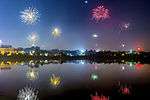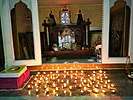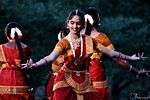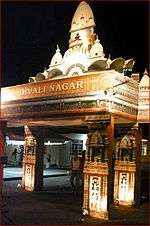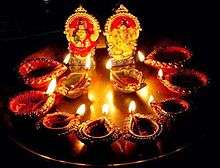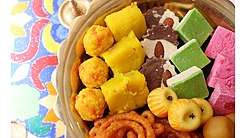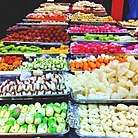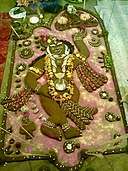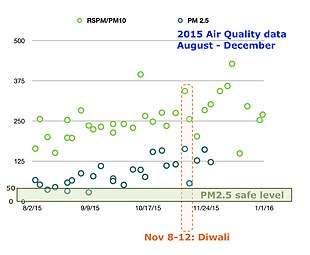Diwali
Diwali, Divali, Deepavali is the Hindu festival of lights, usually lasting five days and celebrated during the Hindu Lunisolar month Kartika (between mid-October and mid-November).[3][4] One of the most popular festivals of Hinduism, Diwali symbolizes the spiritual "victory of light over darkness, good over evil, and knowledge over ignorance".[5][6][7][8] The festival is widely associated with Lakshmi, goddess of prosperity, but regional traditions connect it to Sita and Rama, Vishnu, Krishna, Yama, Yami, Durga, Kali, Dhanvantari, or Vishvakarman.
| Diwali | |
|---|---|
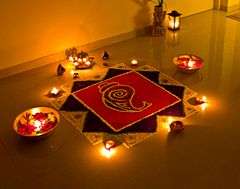 Rangoli decorations, made using coloured fine powder or sand, are popular during Diwali. | |
| Also called | Dipawali |
| Observed by | Hindus, Jains, Sikhs, and some Buddhists (notably Newar Buddhists)[1] |
| Type | Cultural, seasonal, religious |
| Celebrations | Diya and lighting, home decoration, shopping, fireworks, puja (worship ceremonies), gifts, performing religious rituals, feast and sweets |
| Date | Amavasya of Kartik month (Date varies per Hindu calendar) |
| 2020 date | November[2]
|
| Related to | Galungan, Diwali (Jainism), Bandi Chhor Divas, Tihar, Swanti, Sohrai, Bandna |
In the lead-up to Diwali, celebrants will prepare by cleaning, renovating, and decorating their homes and workplaces.[9] During the Diwali people wear their finest clothes, illuminate the interior and exterior of their homes with diyas (oil lamps or candles), offer puja (worship) to Lakshmi, the goddess of prosperity and wealth,[note 1] light fireworks, and partake in family feasts, where mithai (sweets) and gifts are shared. Diwali is also a major cultural event for the Hindu and Jain diaspora from the Indian subcontinent.[12][13][14]
The five-day long festival originated in the Indian subcontinent and is mentioned in early Sanskrit texts. Diwali is usually celebrated eighteen days after the Dussehra (Dasara, Dasain) festival, with Dhanteras, or the regional equivalent, marking the first day of the festival when celebrants prepare by cleaning their homes and making decorations on the floor, such as rangoli.[15] The second day is Naraka Chaturdashi, or the regional equivalent which for Hindus in the south of India is Diwali proper. Western, central, eastern and northern Indian communities observe main day of Diwali on the third day, the day of Lakshmi Puja and the darkest night of the traditional month. In some parts of India, the day after Lakshmi Puja is marked with the Govardhan Puja and Balipratipada (Padwa), which is dedicated to the relationship between wife and husband. Some Hindu communities mark the last day as Bhai Dooj or the regional equivalent, which is dedicated to the bond between sister and brother,[16] while other Hindu and Sikh craftsmen communities mark this day as Vishwakarma Puja and observe it by performing maintenance in their work spaces and offering prayers.[17][18]
Some other faiths in India also celebrate their respective festivals alongside Diwali. The Jains observe their own Diwali which marks the final liberation of Mahavira,[19][20] the Sikhs celebrate Bandi Chhor Divas to mark the release of Guru Hargobind from a Mughal Empire prison,[21] while Newar Buddhists, unlike other Buddhists, celebrate Diwali by worshipping Lakshmi, while the Bengali Hindus generally celebrate Diwali, by worshipping Goddess Kali.[22][23] The main day of the festival of Diwali (the day of Lakshmi Puja) is an official holiday in Fiji,[24] Guyana,[25] India, Malaysia (except Sarawak),[26] Mauritius, Myanmar,[27] Nepal,[28] Singapore,[29] Sri Lanka, Suriname, and Trinidad and Tobago.[30]
Nomenclature and dates
| |||||||||
Diwali (English: /dɪˈwɑːliː/)[3] or Divali[34] is from the Sanskrit dīpāwali meaning "row or series of lights".[35][36] The conjugated term is derived from the Sanskrit words dīpa, "lamp, light, lantern, candle, that which glows, shines, illuminates or knowledge"[37] and āvali, "a row, range, continuous line, series".[38][note 2]
The five-day celebration is observed every year in early autumn after the conclusion of the summer harvest and coincides with the new moon, known as the amāsvasya – the darkest night of the Hindu lunisolar calendar.[39] The festivities begin two days before amāsvasya, on Dhanteras, and extends two days after, the second day of the first fortnight of the month of Kartik.[40] According to Indologist Constance Jones, who specialises in religious sociology, this night ends the lunar month of Ashwin and starts the month of Kartika.[41][note 3] The darkest night is the apex of the celebration and coincides with the second half of October or early November in the Gregorian calendar.[41]
The festival climax is on the third day and is called the main Diwali. It is an official holiday in about a dozen countries, while the other festive days are regionally observed as either public or optional restricted holidays in India.[43] In Nepal, it is also a multiday festival, although the days and rituals are named differently, with the climax being called the Tihar festival by Hindus and Swanti festival by Buddhists.[44][45]
History
The Diwali festival is likely a fusion of harvest festivals in ancient India.[41] It is mentioned in Sanskrit texts such as the Padma Purana, the Skanda Purana both of which were completed in the second half of the 1st millennium CE. The diyas (lamps) are mentioned in Skanda Kishore Purana as symbolising parts of the sun, describing it as the cosmic giver of light and energy to all life and which seasonally transitions in the Hindu calendar month of Kartik.[32][46]
King Harsha refers to Deepavali, in the 7th century Sanskrit play Nagananda, as Dīpapratipadotsava (dīpa = light, pratipadā = first day, utsava = festival), where lamps were lit and newly engaged brides and grooms received gifts.[47][48] Rajasekhara referred to Deepavali as Dipamalika in his 9th century Kavyamimamsa, wherein he mentions the tradition of homes being whitewashed and oil lamps decorated homes, streets and markets in the night.[47]
Diwali was also described by numerous travellers from outside India. In his 11th century memoir on India, the Persian traveller and historian Al Biruni wrote of Deepavali being celebrated by Hindus on the day of the New Moon in the month of Kartika.[49] The Venetian merchant and traveller Niccolò de' Conti visited India in the early 15th-century and wrote in his memoir, "on another of these festivals they fix up within their temples, and on the outside of the roofs, an innumerable number of oil lamps... which are kept burning day and night" and that the families would gather, "clothe themselves in new garments", sing, dance and feast.[50][51] The 16th-century Portuguese traveller Domingo Paes wrote of his visit to the Hindu Vijayanagara Empire, where Dipavali was celebrated in October with householders illuminating their homes, and their temples, with lamps.[51]
Islamic historians of the Delhi Sultanate and the Mughal Empire era also mentioned Diwali and other Hindu festivals. A few, notably the Mughal emperor Akbar, welcomed and participated in the festivities,[52][53] whereas others banned such festivals as Diwali and Holi, as Aurangzeb did in 1665.[54][55][note 4][note 5]
Publications from the British colonial era also made mention of Diwali, such as the note on Hindu festivals published in 1799 by Sir William Jones, a philologist known for his early observations on Sanskrit and Indo-European languages.[58] In his paper on The Lunar Year of the Hindus, Jones, then based in Bengal, noted four of the five days of Diwali in the autumn months of Aswina-Cartica [sic] as the following: Bhutachaturdasi Yamaterpanam (2nd day), Lacshmipuja dipanwita (the day of Diwali), Dyuta pratipat Belipuja (4th day), and Bhratri dwitiya (5th day). The Lacshmipuja dipanwita, remarked Jones, was a "great festival at night, in honor of Lakshmi, with illuminations on trees and houses".[58][note 6]
Epigraphy
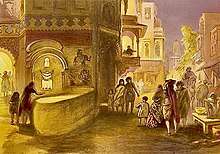
Sanskrit inscriptions in stone and copper mentioning Diwali, occasionally alongside terms such as Dipotsava, Dipavali, Divali and Divalige, have been discovered at numerous sites across India.[60][61][note 7] Examples include a 10th-century Rashtrakuta empire copper plate inscription of Krsna III (939–967 CE) that mentions Dipotsava,[62] and a 12th-century mixed Sanskrit-Kannada Sinda inscription discovered in the Isvara temple of Dharwad in Karnataka where the inscription refers to the festival as a "sacred occasion".[63] According to Lorenz Franz Kielhorn, a German Indologist known for translating many Indic inscriptions, this festival is mentioned as Dipotsavam in verses 6 and 7 of the Ranganatha temple Sanskrit inscription of the 13th-century Kerala Hindu king Ravivarman Samgramadhira. Part of the inscription, as translated by Kielhorn, reads: "the auspicious festival of lights which disperses the most profound darkness, which in former days was celebrated by the kings Ila, Kartavirya and Sagara, (...) as Sakra (Indra) is of the gods, the universal monarch who knows the duties by the three Vedas, afterwards celebrated here at Ranga for Vishnu, resplendent with Lakshmi resting on his radiant lap."[64][note 8]
Jain inscriptions, such as the 10th-century Saundatti inscription about a donation of oil to Jinendra worship for the Diwali rituals, speak of Dipotsava.[65][66] Another early 13th-century Sanskrit stone inscription, written in the Devanagari script, has been found in the north end of a mosque pillar in Jalore, Rajasthan evidently built using materials from a demolished Jain temple. The inscription states that Ramachandracharya built and dedicated a drama performance hall, with a golden cupola, on Diwali.[67][68][note 9]
Religious significance
| Part of a series on |
| Hinduism |
|---|
 |
|
|
Main traditions
|
|
Concepts
|
|
Practices Worship
Arts
Festivals
|
|
Philosophical schools
|
|
Gurus, saints, philosophers
|
|
Texts Scriptures
Other texts
Text classification
|
|
Other topics
|
|
Diwali is celebrated by Hindus, Jains, Sikhs, and Newar Buddhists,[22] although for each faith it marks different historical events and stories, but nonetheless the festival represents the same symbolic victory of light over darkness, knowledge over ignorance, and good over evil.[5][6][69][70]
Hinduism
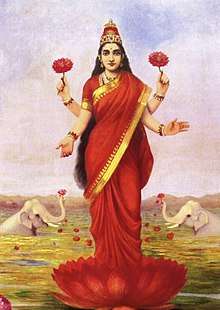
The religious significance of Diwali varies regionally within India. The festival is associated with a diversity of deities, traditions, and symbolism.[5][71][36] These variations, states Constance Jones, may reflect diverse local autumn harvest festivals that fused into one pan-Hindu festival with a shared spiritual significance and ritual grammar while retaining local traditions.[8]
One tradition links the festival to legends in the Hindu epic Ramayana, where Diwali is the day Rama, Sita, Lakshmana and Hanuman reached Ayodhya after a period in exile and Rama's army of good defeated demon king Ravana's army of evil.[72]
As per another popular tradition, in the Dwapara Yuga Period, Vishnu as incarnation of Krishna killed the Demon Narakasura, who was evil king of Pragjyotishapura, near present-day Assam and released 16000 girls captivated by Narakasura. Diwali was celebrated as a significance of triumph of good over evil after Krishna's Victory over Narakasura. The day before Diwali is remembered as Naraka Chaturdasi, the day on which Narakasura was killed by Krishna.[73]
Many Hindus associate the festival with Lakshmi, the goddess of wealth and prosperity, and wife of Vishnu. According to Pintchman, the start of the 5-day Diwali festival is stated in some popular contemporary sources as the day Goddess Lakshmi was born from Samudra manthan, the churning of the cosmic ocean of milk by the Devas (gods) and the Asuras (demons) – a Vedic legend that is also found in several Puranas such as the Padma Purana, while the night of Diwali is when Lakshmi chose and wed Vishnu.[32][74] Along with Lakshmi, who is representative of Vaishnavism, Ganesha, the elephant-headed son of Parvati and Shiva of Shaivism tradition, is remembered as one who symbolises ethical beginnings and the remover of obstacles.[72]
Hindus of eastern India associate the festival with the goddess Durga, or her fierce avatar Kali (Shaktism), who symbolises the victory of good over evil.[10][75][76] Hindus from the Braj region in northern India, parts of Assam, as well as southern Tamil and Telugu communities view Diwali as the day the god Krishna overcame and destroyed the evil demon king Narakasura, in yet another symbolic victory of knowledge and good over ignorance and evil.[77][78]
Trade and merchant families and others also offer prayers to Saraswati, who embodies music, literature and learning and Kubera, who symbolises book-keeping, treasury and wealth management.[32] In western states such as Gujarat, and certain northern Hindu communities of India, the festival of Diwali signifies the start of a new year.[77]
Mythical tales shared on Diwali vary widely depending on region and even within Hindu tradition,[71] yet all share a common focus on righteousness, self-inquiry and the importance of knowledge,[79][80] which, according to Lindsey Harlan, an Indologist and scholar of Religious Studies, is the path to overcoming the "darkness of ignorance".[81] The telling of these myths are a reminder of the Hindu belief that good ultimately triumphs over evil.[82][83]
Jainism
A scholar of Jain and Nivethan, states that in Jain tradition, Diwali is celebrated in observance of "Mahavira Nirvana Divas", the physical death and final nirvana of Mahavira. The Jain Diwali celebrated in many parts of India has similar practices to the Hindu Diwali, such as the lighting of lamps and the offering of prayers to Lakshmi. However, the focus of the Jain Diwali remains the dedication to Mahavira.[84] According to the Jain tradition, this practice of lighting lamps first began on the day of Mahavira's nirvana in 527 BCE,[note 10] when 18 kings who had gathered for Mahavira's final teachings issued a proclamation that lamps be lit in remembrance of the "great light, Mahavira".[87][88] This traditional belief of the origin of Diwali, and its significance to Jains, is reflected in their historic artworks such as paintings.[89]
Sikhism
Sikhs celebrate Bandi Chhor Divas in remembrance of the release of Guru Hargobind from the Gwalior Fort prison by the Mughal emperor, Jahangir, and the day he arrived at the Golden Temple in Amritsar.[90] According to J.S. Grewal, a scholar of Sikhism and Sikh history, Diwali in the Sikh tradition is older than the sixth Guru Hargobind legend. Guru Amar Das, the third Guru of the Sikhs, built a well in Goindwal with eighty-four steps and invited Sikhs to bathe in its sacred waters on Baisakhi and Diwali as a form of community bonding. Over time, these spring and autumn festivals became the most important of Sikh festivals and holy sites such as Amritsar became focal points for annual pilgrimages.[91] The festival of Diwali, according to Ray Colledge, highlights three events in Sikh history: the founding of the city of Amritsar in 1577, the release of Guru Hargobind from the Mughal prison, and the day of Bhai Mani Singh's martyrdom in 1738 as a result of his failure to pay a fine for trying to celebrate Diwali and thereafter refusing to convert to Islam.[92][93][note 11]
Buddhism
Diwali is not a festival for most Buddhists, with the exception of the Newar people of Nepal who revere various deities in the Vajrayana Buddhism and celebrate Diwali by offering prayers to Lakshmi.[22][23] Newar Buddhists in Nepalese valleys also celebrate the Diwali festival over five days, in much the same way, and on the same days, as the Nepalese Hindu Diwali-Tihar festival.[96] According to some observers, this traditional celebration by Newar Buddhists in Nepal, through the worship of Lakshmi and Vishnu during Diwali, is not syncretism but rather a reflection of the freedom within Mahayana Buddhist tradition to worship any deity for their worldly betterment.[22]
Description
Diwali is a five-day festival, the height of which is celebrated on the third day coinciding with the darkest night of the lunar month. During the festival, Hindus, Jains and Sikhs illuminate their homes, temples and work spaces with diyas, candles and lanterns[8] Hindus, in particular, have a ritual oil bath at dawn on each day of the festival.[99] Diwali is also marked with fireworks and the decoration of floors with rangoli designs. Food is a major focus with families partaking in feasts and sharing mithai.[35] The festival is an annual homecoming and bonding period not only for families,[33][100] but also for communities and associations, particularly those in urban areas, which will organise activities, events and gatherings.[101][102] Many towns organise community parades and fairs with parades or music and dance performances in parks.[103] Some Hindus, Jains and Sikhs will send Diwali greeting cards to family near and far during the festive season, occasionally with boxes of Indian confectionery.[103]
Diwali is a post-harvest festival celebrating the bounty following the arrival of the monsoon in the subcontinent.[83] Depending on the region, celebrations include prayers before one or more Hindu deities, the most common being Lakshmi.[33][100] According to David Kinsley, an Indologist and scholar of Indian religious traditions particularly in relation to goddess worship, Lakshmi symbolises three virtues: wealth and prosperity, fertility and abundant crops, as well as good fortune.[98] Merchants seek Lakshmi's blessings in their ventures and will ritually close their accounting year during Diwali.[98] Fertility motifs appear in agricultural offerings brought before Lakshmi by farming families, who give thanks for the recent harvests and seek her blessings for prosperous future crops.[98] A symbolic piece of traditional fertiliser, a dried piece of cow dung, is included in the ensemble in Odisha and Deccan region villages, an agricultural motif according to Kinsley.[98] Another aspect of the festival is remembering the ancestors.[104] .
Rituals and preparations for Diwali begin days or weeks in advance, typically after the festival of Dusshera that precedes Diwali by about 20 days.[72] The festival formally begins two days before the night of Diwali, and ends two days thereafter. Each day has the following rituals and significance:[32]
Dhanteras, Dhanatrayodashi (Day 1)
Dhanteras, derived from Dhan meaning wealth and teras meaning thirteenth, marks the thirteenth day of the dark fortnight of Kartik and the beginning of Diwali.[105] On this day, many Hindus clean their homes and business premises. They install diyas, small earthen oil-filled lamps that they light up for the next five days, near Lakshmi and Ganesha iconography.[105][97] Women and children decorate doorways within homes and offices with rangoli, colourful designs made from rice flour, flower petals and coloured sand,[103] while the boys and men decorate the roofs and walls of family homes, markets, and temples. The day also marks a major shopping day to purchase new utensils, home equipment, jewellery, firecrackers, and other items.[97][32][74] On the evening of Dhanteras, families offer prayers (puja) to Lakshmi and Ganesha, and lay offerings of puffed rice, candy toys, rice cakes and batashas (hollow sugar cakes).[97]
According to Tracy Pintchman, Dhanteras is a symbol of annual renewal, cleansing and an auspicious beginning for the next year.[105] The term "Dhan" for this day also alludes to the Ayurvedic icon Dhanvantari, the god of health and healing, who is believed to have emerged from the "churning of cosmic ocean" on the same day as Lakshmi.[105] Some communities, particularly those active in Ayurvedic and health-related professions, pray or perform havan rituals to Dhanvantari on Dhanteras.[105]
Naraka Chaturdashi, Chhoti Diwali (Day 2)
Naraka Chaturdashi also known as Chhoti Diwali, is the second day of festivities coinciding with the fourteenth day of the second fortnight of the lunar month. The term "chhoti" means little, while "Naraka" means hell and "Chaturdashi" means "fourteenth".[106] The day and its rituals are interpreted as ways to liberate any souls from their suffering in "Naraka", or hell, as well as a reminder of spiritual auspiciousness. For some Hindus, it is a day to pray for the peace to the manes, or deified souls of one's ancestors and light their way for their journeys in the cyclic afterlife.[107] A mythological interpretation of this festive day is the destruction of the asura (demon) Narakasura by Krishna, a victory that frees 16,000 imprisoned princesses kidnapped by Narakasura.[106]
Naraka Chaturdashi is also a major day for purchasing festive foods, particularly sweets. A variety of sweets are prepared using flour, semolina, rice, chickpea flour, dry fruit pieces powders or paste, milk solids (mawa or khoya) and clarified butter (ghee).[83] According to Goldstein, these are then shaped into various forms, such as laddus, barfis, halwa, kachoris, shrikhand, and sandesh, rolled and stuffed delicacies, such as karanji, shankarpali, maladu, susiyam, pottukadalai. Sometimes these are wrapped with edible silver foil (vark). Confectioners and shops create Diwali-themed decorative displays, selling these in large quantities, which are stocked for home celebrations to welcome guests and as gifts.[83][97] Families also prepare homemade delicacies for Lakshmi Pujan, regarded as the main day of Diwali.[83] Chhoti Diwali is also a day for visiting friends, business associates and relatives, and exchanging gifts.[97]
This day is commonly celebrated as Diwali in Tamil Nadu, Goa, and Karnataka. Traditionally, Marathi people and South Indian Hindus receive an oil massage from the elders in the family on the day and then take a ritual bath, all before sunrise.[108] Many visit their favourite Hindu temple.[109]
Lakshmi Pujan (Day 3)
The third day is the height of the festival,[110] and coincides with the last day of the dark fortnight of the lunar month. This is the day when Hindu, Jain and Sikh temples and homes are aglow with lights, thereby making it the "festival of lights". The word Deepawali comes from the word the Sanskrit word deep, which means an Indian lantern/lamp.[39][111]
The youngest members in the family visit their elders, such as grandparents and other senior members of the community, on this day. Small business owners give gifts or special bonus payments to their employees between Dhanteras and Lakshmi Pujan.[108][112] Shops either do not open or close early on this day allowing employees to enjoy family time. Shopkeepers and small operations perform puja rituals in their office premises. Unlike some other festivals, the Hindu typically do not fast during the five-day long Diwali including Lakshmi Pujan, rather they feast and share the bounties of the season at their workplaces, community centres, temples and homes.[108]
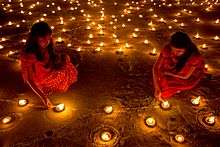
As the evening approaches, celebrants will wear new clothes or their best outfits, teenage girls and women, in particular, wear saris and jewellery.[113] At dusk, family members gather for the Lakshmi Pujan,[113] although prayers will also be offered to other deities, such as Ganesha, Saraswati, Rama, Lakshmana, Sita, Hanuman, or Kubera.[32] The lamps from the puja ceremony are then used to light more earthenware lamps, which are placed in rows along the parapets of temples and houses,[114] while some diyas are set adrift on rivers and streams.[7][115][116] After the puja, people go outside and celebrate by lighting up patakhe (fireworks) together, and then share a family feast and mithai (sweets, desserts).[32]
The puja and rituals in the Bengali Hindu community focus on Kali, the goddess of war, instead of Lakshmi.[11][117] According to Rachel Fell McDermott, a scholar of South Asian, particular Bengali, studies, in Bengal during Navaratri (Dussehra elsewhere in India) the Durga puja is the main focus, although in the eastern and north eastern states the two are synonymous, but on Diwali the focus is on the puja dedicated to Kali. These two festivals likely developed in tandem over their recent histories, states McDermott.[11] Textual evidence suggests that Bengali Hindus worshipped Lakshmi before the colonial era, and that the Kali puja is a more recent phenomenon.[note 12] Contemporary Bengali celebrations mirror those found elsewhere, with teenage boys playing with fireworks and the sharing of festive food with family, but with the Shakti goddess Kali as the focus.[118]

On the night of Diwali, rituals across much of India are dedicated to Lakshmi to welcome her into their cleaned homes and bring prosperity and happiness for the coming year.[119] While the cleaning, or painting, of the home is in part for goddess Lakshmi, it also signifies the ritual "reenactment of the cleansing, purifying action of the monsoon rains" that would have concluded in most of the Indian subcontinent.[119] Vaishnava families recite Hindu legends of the victory of good over evil and the return of hope after despair on the Diwali night, where the main characters may include Rama, Krishna, Vamana or one of the avatars of Vishnu, the divine husband of Lakshmi.[119][120] At dusk, lamps placed earlier in the inside and outside of the home are lit up to welcome Lakshmi.[110] Family members light up firecrackers, which some interpret as a way to ward off all evil spirits and the inauspicious, as well as add to the festive mood.[121][122] According to Pintchman, who quotes Raghavan, this ritual may also be linked to the tradition in some communities of paying respect to ancestors. Earlier in the season's fortnight, some welcome the souls of their ancestors to join the family for the festivities with the Mahalaya. The Diwali night's lights and firecrackers, in this interpretation, represent a celebratory and symbolic farewell to the departed ancestral souls.[123]
The celebrations and rituals of the Jains and the Sikhs are similar to those of the Hindus where social and community bonds are renewed. Major temples and homes are decorated with lights, festive foods shared with all, friends and relatives remembered and visited with gifts.[112][84]
Annakut, Balipratipada (Padwa), Govardhan puja (Day 4)
The day after Diwali is the first day of the bright fortnight of the luni-solar calendar.[124] It is regionally called as Annakut (heap of grain), Padwa, Goverdhan puja, Bali Pratipada, Bali Padyami, Kartik Shukla Pratipada and other names.[103][124] According to one tradition, the day is associated with the story of Bali's defeat at the hands of Vishnu.[125][126] In another interpretation, it is thought to reference the legend of Parvati and her husband Shiva playing a game of dyuta (dice) on a board of twelve squares and thirty pieces, Parvati wins. Shiva surrenders his shirt and adornments to her, rendering him naked.[124] According to Handelman and Shulman, as quoted by Pintchman, this legend is a Hindu metaphor for the cosmic process for creation and dissolution of the world through the masculine destructive power, as represented by Shiva, and the feminine procreative power, represented by Parvati, where twelve reflects the number of months in the cyclic year, while thirty are the number of days in its lunisolar month.[124]
This day ritually celebrates the bond between the wife and husband,[127] and in some Hindu communities, husbands will celebrate this with gifts to their wives. In other regions, parents invite a newly married daughter, or son, together with their spouses to a festive meal and give them gifts.[127]
In some rural communities of the north, west and central regions, the fourth day is celebrated as Govardhan puja, honouring the legend of the Hindu god Krishna saving the cowherd and farming communities from incessant rains and floods triggered by Indra's anger,[127] which he accomplished by lifting the Govardhan mountain. This legend is remembered through the ritual of building small mountain-like miniatures from cow dung.[127] According to Kinsley, the ritual use of cow dung, a common fertiliser, is an agricultural motif and a celebration of its significance to annual crop cycles.[98][128][129]
The agricultural symbolism is also observed on this day by many Hindus as Annakut, literally "mountain of food". Communities prepare over one hundred dishes from a variety of ingredients, which is then dedicated to Krishna before shared among the community. Hindu temples on this day prepare and present "mountains of sweets" to the faithful who have gathered for darshan (visit).[127] In Gujarat, Annakut is the first day of the new year and celebrated through the purchase of essentials, or sabras (literally, "good things in life"), such as salt, offering prayers to Krishna and visiting temples.[127]
Bhai Duj, Bhau-Beej (Day 5)
The last day of the festival is called Bhai Duj (literally "brother's day"[130]), Bhau Beej, Bhai Tilak or Bhai Phonta. It celebrates the sister-brother bond, similar in spirit to Raksha Bandhan but it is the brother that travels to meet the sister and her family. This festive day is interpreted by some to symbolise Yama's sister Yamuna welcoming Yama with a tilaka, while others interpret it as the arrival of Krishna at his sister's, Subhadra, place after defeating Narakasura. Subhadra welcomes him with a tilaka on his forehead.[127][131]
The day celebrates the sibling bond between brother and sister. On this day the womenfolk of the family gather, perform a puja with prayers for the well being of their brothers, then return to a ritual of feeding their brothers with their hands and receiving gifts. According to Pintchman, in some Hindu traditions the women recite tales where sisters protect their brothers from enemies that seek to cause him either bodily or spiritual harm.[131] In historic times, this was a day in autumn when brothers would travel to meet their sisters, or invite their sister's family to their village to celebrate their sister-brother bond with the bounty of seasonal harvests.[32]
The artisan Hindu and Sikh community celebrates the fourth day as the Vishwakarma puja day.[note 13] Vishwakarma is the presiding Hindu deity for those in architecture, building, manufacturing, textile work and crafts trades.[17] [note 14] The looms, tools of trade, machines and workplaces are cleaned and prayers offered to these livelihood means.[134]
Other traditions and significance
During the season of Diwali, numerous rural townships and villages host melas,[135] or fairs, where local producers and artisans trade produce and goods. A variety of entertainments are usually available for inhabitants of the local community to enjoy. The women, in particular, adorn themselves in colourful attire and decorate their hands with henna. Such events are also mentioned in Sikh historical records.[136][note 15] In the modern day, Diwali mela are held at college, or university, campuses or as community events by members of the Indian diaspora. At such events a variety of music, dance and arts performances, food, crafts, and cultural celebrations are featured.[137][138][81]
Economics
Diwali marks a major shopping period in India,[12] and is comparable to the Christmas period in terms of consumer purchases and economic activity.[139] It is traditionally a time when households purchase new clothing, home refurbishments, gifts, gold, jewellery,[140][141] and other large purchases particularly as the festival is dedicated to Lakshmi, the goddess of wealth and prosperity, and such purchases are considered auspicious.[142][143] According to Rao, Diwali is one of the major festivals where rural Indians spend a significant portion of their annual income, and is a means for them to renew their relationships and social networks.[144] Other goods that are bought in substantial quantities during Diwali include confectionery and fireworks. In 2013, about ₹25 billion (US$350 million) of fireworks were sold to merchants for the Diwali season, an equivalent retail value of about ₹50 billion (US$700 million) according to The Times of India.[145][note 16] ASSOCHAM, a trade organisation in India, forecasted that online shopping alone to be over ₹300 billion (US$4.2 billion) over the 2017 Diwali season.[148] About two-thirds of Indian households, according to the ASSOCHAM forecast, would spend between ₹5,000 (US$70) and ₹10,000 (US$140) to celebrate Diwali in 2017.[149]
Politics
Diwali has increasingly attracted cultural exchanges, becoming occasions for politicians and religious leaders worldwide to meet Hindu or Indian origin citizens, diplomatic staff or neighbours. Many participate in other socio-political events as a symbol of support for diversity and inclusiveness. The Catholic dicastery Pontifical Council for Interreligious Dialogue, founded as Secretariat for non-Christians by Pope Paul VI, began sending official greetings and Pope's message to the Hindus on Diwali in the mid-1990s.[150][note 17]
Many governments encourage or sponsor Diwali-related festivities in their territories. For example, the Singaporean government, in association with the Hindu Endowment Board of Singapore, organises many cultural events during Diwali every year.[151] National and civic leaders such as Prince Charles have attended Diwali celebrations at prominent Hindu temples in the UK, such as the Swaminarayan Temple in Neasden, using the occasion to highlight contributions of the Hindu community to British society.[152][153] Since 2009, Diwali has been celebrated every year at 10 Downing Street, the residence of the British Prime Minister.[154]
Diwali was first celebrated in the White House by George W. Bush in 2003 and was given official status by the United States Congress in 2007.[155][156] Barack Obama became the first president to personally attend Diwali at the White House in 2009. On the eve of his first visit to India as President of the United States, Obama released an official statement sharing his best wishes with "those celebrating Diwali".[157]
Every year during Diwali, Indian forces approach their Pakistani counterparts at the border bearing gifts of traditional Indian confectionery, a gesture that is returned in kind by the Pakistani soldiers who give Pakistani sweets to the Indian soldiers.[158][note 18]
Issues
Air pollution
The 51% of which is caused by the industrial pollution, 27% by vehicles, 8% by crop burning and 5% by diwali fireworks.[164] The tradition of annual Diwali fireworks has caused widespread coverage in Indian media, where debate has centred on air quality within Indian cities in autumn and winter and the role the fireworks play. On 9 October 2017, the Supreme Court of India banned the sale, but not use, of fireworks in Delhi during the Diwali season,[165] with the assumption that banning the use of fireworks would substantially improve the air quality of Delhi. Critics stated that the ruling was judicial over-reach and a bias against Hindu culture, while supporters stated that it would be beneficial to public health.[165]
Scholars have stated that many factors contribute to the poor air quality in Delhi, and northern India, that accompanies the harvest festival of Diwali. According to Jethva and others, the post-monsoon custom is to prepare the crop fields by deliberately burning the residual stubble between October and November.[166][167] As crop productivity per hectare has increased with mechanised harvesting, this has led to the practice becoming more widespread in the northern and northwestern regions of India in the months when Diwali is observed.[166] The smoke from the burning of the fields is carried by seasonal winds over the floodplain, where it is inverted by the colder winds and spread throughout the region for much of the winter. Other contributors to the poor air quality include daily vehicular and industrial activity along with the burning of other biomass.[166][167]
A study of residential areas of Delhi in 2006-08, found that concentration of particulate matter as well as sulphur dioxide increased on the day of Diwali relative to other days of the month and that the increase could be exacerbated by prevailing meteorological conditions; there was also a correlated increase in ambient noise levels.[168] Another study of air pollution in Delhi found that the PM2.5 levels in 2015 and 2016 did rise over Diwali, but these higher levels were "a result of contribution from fireworks on the Diwali night, trans-regional movement of pollutants due to crop residue burning, low wind speed, and high humidity". The authors concluded that the contribution of the festival fireworks could lead to a 1.3% increase in the non-carcinogenic hazard index.[169] Other studies have stated that the fireworks of Diwali produce particulates and pollutants with a decay-life time of about one day.[note 19]
Burn injuries
The use of fireworks also causes an increase in the number of burn injuries in India during Diwali. One particular firework called anar (fountain) has been found to be responsible for 65% of such injuries, with adults being the typical victims. Most of the injuries sustained are Group I type burns (minor) requiring only outpatient care.[172][173]
See also
- Kali Puja – Diwali is most commonly known as Kali Puja in West Bengal or in Bengali dominated areas
- Karthikai Deepam - the festival of lights observed by Tamils of Tamil Nadu, Puducherry, Kerala, Sri Lanka and elsewhere
- Galungan – the Balinese Hindu festival of dharma's victory over adharma
- Hanukkah – the Jewish festival of lights
- Lantern Festival – the Chinese festival of lanterns
- Saint Lucy's Day – the Christian festival of lights
- Walpurgis Night – the German festival of bonfires
- Rama - God
Notes
- Hindus of eastern and northeastern states of India associate the festival with the goddess Durga, or her fierce avatar Kali (Shaktism).[10] According to McDermott, this region also celebrated the Lakshmi puja historically, while the Kali puja tradition started in the colonial era and was particular prominent post-1920s.[11]
- The holiday is known as dipawoli in Assamese: দীপাৱলী, dipaboli or dipali in Bengali: দীপাবলি/দীপালি, divāḷi in Gujarati: દિવાળી, divālī in Hindi: दिवाली, dīpavaḷi in Kannada: ದೀಪಾವಳಿ, Konkani: दिवाळी, Malayalam: ദീപാവലി, Marathi: दिवाळी, dipābali in Odia: ଦିପାବଳୀ, dīvālī in Punjabi: ਦੀਵਾਲੀ, diyārī in Sindhi: दियारी, tīpāvaḷi in Tamil: தீபாவளி, and Telugu: దీపావళి, Galungan in Balinese and Swanti in Nepali: स्वन्ति or tihar in Nepali: तिहार and Thudar Parba in Tulu: ತುಡರ್ ಪರ್ಬ.
- Historical records appear inconsistent about the name of the lunar month in which Diwali is observed. One of the earliest reports on this variation was by Wilson in 1847. He explained that though the actual Hindu festival day is the same, it is identified differently in regional calendars because there are two traditions in the Hindu calendar. One tradition starts a new month from the new moon, while the other starts it from the full moon.[42]
- According to Audrey Truschke, the Sunni Muslim emperor Aurangzeb did limit "public observation" of many religious holidays such as Hindu Diwali and Holi, but also of Shia observance of Muharram and the Persian holiday of Nauruz. According to Truschke, Aurangzeb did so because he found the festivals "distasteful" and also from "concerns with public safety" lurking in the background.[56] According to Stephen Blake, a part of the reason that led Aurangzeb to ban Diwali was the practice of gambling and drunken celebrations.[55] Truschke states that Aurangzeb did not ban private practices altogether and instead "rescinded taxes previously levied on Hindu festivals" by his Mughal predecessors.[56] John Richards disagrees and states Aurangzeb, in his zeal to revive Islam and introduce strict Sharia in his empire, issued a series of edicts against Hindu festivals and shrines.[57] According to Richards, it was Akbar who abolished the discriminatory taxes on Hindu festivals and pilgrims, and it was Aurangzeb who reinstated the Mughal era discriminatory taxes on festivals and increased other religion-based taxes.[57]
- Some Muslims joined the Hindu community in celebrating Diwali in the Mughal era. Illustrative Islamic records, states Stephen Blake, include those of 16th-century Sheikh Ahmad Sirhindi who wrote, "during Diwali.... the ignorant ones amongst Muslims, particularly women, perform the ceremonies... they celebrate it like their own Id and send presents to their daughters and sisters,.... they attach much importance and weight to this season [of Diwali]."[55]
- Williams Jones stated that the Bhutachaturdasi Yamaterpanam is dedicated to Yama and ancestral spirits, the Lacshmipuja dipanwita to goddess Lakshmi with invocations to Kubera, the Dyuta pratipat Belipuja to Shiva-Parvati and Bali legends, and the Bhratri dwitiya to Yama-Yamuna legend and the Hindus celebrate the brother-sister relationship on this day.[58] Jones also noted that on the Diwali day, the Hindus had a mock cremation ceremony with "torches and flaming brands" called Ulcadanam, where they said goodbye to their colleagues who had died in war or in a foreign country and had never returned home. The ceremony lit the path of the missing to the mansion of Yama.[58]
- Some inscriptions mention the festival of lights in Prakrit terms such as tipa-malai, sara-vilakku and others.
- The Sanskrit inscription is in the Grantha script. It is well preserved on the north wall of the second prakara in the Ranganatha temple, Srirangam island, Tamil Nadu.[64]
- The Diwali-related inscription is the 4th inscription and it includes the year Vikrama Era 1268 (c. 1211 CE).[67]
- Scholars contest the 527 BCE date and consider Mahavira's biographical details as uncertain. Some suggest he lived in the 5th-century BCE contemporaneously with the Buddha.[85][86]
- Sikhs historically referred to this festival as Diwali. It was in early 20th-century, states Harjot Oberoi – a scholar of Sikh history, when the Khalsa Tract Society triggered by the Singh Sabha Movement sought to establish a Sikh identity distinct from the Hindus and the Muslims.[94] They launched a sustained campaign to discourage Sikhs from participating in Holi and Diwali, renaming the festivals, publishing the seasonal greeting cards in the Gurmukhi language and relinking their religious significance to Sikh historical events.[95] While some of these efforts have had a lasting impact for the Sikh community, the lighting, feasting together, social bonding, sharing and other ritual grammar of Sikh celebrations during the Diwali season are similar to those of the Hindus and Jains.[95]
- According to McDermott, while the Durga Puja is the largest Bengali festival and it can be traced to the 16th-century or earlier, the start of Kali puja tradition on Diwali is traceable to no earlier than about the mid-18th-century during the reign of Raja Krishnacandra Ray.[11] McDermott further writes that the older historic documents of the Bengal confirm that the Bengali Hindus have long celebrated the night of Diwali with illuminations, firecrackers, foods, new account books, Lakshmi (not Kali), inviting their friends (including Europeans during the colonial era) and gambling.[11] The Kali sarbajanin tradition on Diwali, with tantric elements in some locations, grew slowly into a popular Bengali tradition after the mid-1920s.[11]
- According to a Government of Himachal Pradesh and India publication, the Vishvakarma puja is observed on the fourth day of Diwali in the Himalayan state.[132]
- The Vishwakarma puja day is alternatively observed in other Hindu communities in accordance with the Hindu solar calendar, and this falls in September.[133]
- Max Macauliffe, who lived in northwest Punjab area during the colonial era and is known for his work on Sikh literature and history, wrote about Diwali melas to which people visited to buy horses, seek pleasure, pray in nearby Amritsar temples for the prosperity of their children and their souls, and some on "errands, more or less worthy or unworthy character".[136]
- A 2017 estimate states 50,000 tons (100 million pounds) of fireworks are exploded annually in India over the Diwali festival.[146] As a comparison, Americans explode 134,000 tons (268 million pounds) of fireworks for the 4th of July celebrations in the United States.[147]
- The Pontifical Council for Interreligious Dialogue was founded as Secretariat for non-Christians by Pope Paul VI. It began sending official greetings and message to Muslims in 1967 on Id al-Fitr. About 30 years later, in the mid-1990s the Catholic authorities began sending two additional annual official greetings and message, one to the Hindus on Diwali and the other to the Buddhists on Buddha's birthday.[150]
- Diwali was not a public holiday in Pakistan from 1947 to 2016. Diwali along with Holi for Hindus, and Easter for Christians, was adopted as public holiday resolution by Pakistan's parliament in 2016, giving the local governments and public institutions the right to declare Holi as a holiday and grant leave for its minority communities, for the first time.[159][160] Diwali celebrations have been relatively rare in contemporary Pakistan, but observed across religious lines, including by Muslims in cities such as Peshawar.[161]
- According to a study done by Barman in Lucknow, India, the amount of fine (PM2.5) particulates in the air can worsen following firework celebrations, but not during it. High accumulations of particulates produced from fireworks can remain suspended in the air for around 48 hours after their use.[170] Another study indicated that ground-level ozone pollution is also generated by fireworks; their dispersal and decay times is also about one day.[171]
References
- Townsend, Charles M (March 2014). TheOxford Handbook of Sikh Studies. Oxford University Press. p. 440. ISBN 978-0-19-969930-8.
- https://www.drikpanchang.com/calendars/hindu/hinducalendar.html?year=2020
- The New Oxford Dictionary of English (1998) ISBN 978-0-19-861263-6 – p. 540 "Diwali /dɪwɑːli/ (also Diwali) noun a Hindu festival with lights...".
- Diwali Encyclopædia Britannica (2009)
- Vasudha Narayanan; Deborah Heiligman (2008). Celebrate Diwali. National Geographic Society. p. 31. ISBN 978-1-4263-0291-6.
All the stories associated with Deepavali, however, speak of the joy connected with the victory of light over darkness, knowledge over ignorance, and good over evil.
- Tina K Ramnarine (2013). Musical Performance in the Diaspora. Routledge. p. 78. ISBN 978-1-317-96956-3.
Light, in the form of candles and lamps, is a crucial part of Diwali, representing the triumph of light over darkness, goodness over evil and hope for the future.
- Jean Mead, How and why Do Hindus Celebrate Divali?, ISBN 978-0-237-53412-7
- Constance Jones 2011, pp. 252–255
- Pramodkumar (March 2008). Meri Khoj Ek Bharat Ki. ISBN 978-1-4357-1240-9. Retrieved 26 October 2011.
It is extremely important to keep the house spotlessly clean and pure on Diwali. The Goddess Lakshmi likes cleanliness, and she will visit the cleanest house first. Lamps are lit in the evening to welcome the goddess. They are believed to light up her path.
- Laura Amazzone 2012.
- McDermott 2011, pp. 183–188.
- India Journal: ‘Tis the Season to be Shopping Devita Saraf, The Wall Street Journal (August 2010)
- Henry Johnson 2007, pp. 71–73.
- Kelly 1988, pp. 40–55.
- Karen Bellenir (1997), Religious Holidays and Calendars: An Encyclopedic Handbook, 2nd Edition, ISBN 978-0-7808-0258-2, Omnigraphics
- Rajat Gupta; Nishant Singh; Ishita Kirar. Hospitality & Tourism Management. Vikas. p. 84. ISBN 978-93-259-8244-4.
- Kristen Haar; Sewa Singh Kalsi (2009). Sikhism. Infobase Publishing. pp. 98–99. ISBN 978-1-4381-0647-2.
- Shobhna Gupta (2002). Festivals of India. Har-Anand. p. 84. ISBN 978-81-241-0869-7.
- Sharma, S.P.; Gupta, Seema (2006). Fairs and Festivals of India. Pustak Mahal. p. 79. ISBN 978-81-223-0951-5.
- Upadhye, A.N. (January–March 1982). Cohen, Richard J. (ed.). "Mahavira and His Teachings". Journal of the American Oriental Society. 102 (1): 231–232. doi:10.2307/601199. JSTOR 601199.
- Geoff Teece (2005). Sikhism. p. 23. ISBN 978-1-58340-469-0.
- Todd T. Lewis. Popular Buddhist Texts from Nepal: Narratives and Rituals of Newar Buddhism. State University of New York Press. pp. 118–119. ISBN 978-0-7914-9243-7.
- Prem Saran (2012). Yoga, Bhoga and Ardhanariswara: Individuality, Wellbeing and Gender in Tantra. Routledge. p. 175. ISBN 978-1-136-51648-1.
- Public Holidays, Government of Fiji
- Public Holidays, Guyana
- Public Holidays Archived 5 March 2019 at the Wayback Machine, Government of Malaysia
- Public Holidays Archived 17 August 2018 at the Wayback Machine, Government of Myanmar
- Public Holidays, Government of Nepal
- Public Gazetted Holidays, Government of Singapore
- Official Public Holidays, Government of Trinidad & Tobago
- Frank Salamone (2004), Encyclopedia of Religious Rites, Rituals and Festivals, ISBN 978-0-415-88091-6, Routledge, pp 112–113, 174, 252
- Tracy Pintchman 2005, pp. 59–65
- Deborah Heiligman, Celebrate Diwali, ISBN 978-0-7922-5923-7, National Geographic Society, Washington, D.C.
- Cybelle T. Shattuck 1999, pp. 51, 124.
- James G. Lochtefeld 2002, pp. 200–201
- Jessica Frazier & Gavin Flood 2011, p. 255.
- Monier Monier Williams (2008 updated, Harvard University), Sanskrit English dictionary, दीप, p. 481
- Monier Monier Williams (2008 updated, Harvard University), Sanskrit English dictionary, आवलि, p. 155
- Tracy Pintchman 2005, pp. 61–62.
- Tracy Pintchman 2005, p. 61.
- Constance Jones 2011, pp. 252–253.
- H.H. Wilson (1847). "Religious festivals of the Hindus". Journal of the Royal Asiatic Society of Great Britain and Ireland. 9: 61.
- "Indian Government Holiday Calendar". National Portal of India. Retrieved 16 November 2016.
- Robert Isaac Levy; Kedar Raj Rajopadhyaya (1990). Mesocosm: Hinduism and the Organization of a Traditional Newar City in Nepal. University of California Press. pp. 411–417. ISBN 978-0-520-06911-4.
- Shrestha, Bal Gopal (July 2006). "The Svanti Festival: Victory over Death and the Renewal of the Ritual Cycle in Nepal" (PDF). Contributions to Nepalese Studies. 33 (2): 206–221.
- James G. Lochtefeld 2002, p. 355.
- BN Sharma, Festivals of India, South Asia Books, ISBN 978-0-8364-0283-4, pp. 9–35
- Varadpande, Manohar Laxman (1987). History of Indian Theatre, Volume 1. Abhinav Publications. p. 159. ISBN 978-81-7017-221-5.
- R.N. Nandi (2009), in A Social History of Early India (Editor: B. Chattopadhyaya), Volume 2, Part 5, Pearson Education, ISBN 978-81-317-1958-9, pp. 183–84
- Abraham Eraly 2015, pp. 315–316.
- Robert Sewell 2006, pp. 85–86.
- Richard M. Eaton 1996, pp. 159–160 with footnotes.
- Charles Melville 2012, p. 526.
- Kiyokazu Okita 2014, pp. 28–29.
- Stephen Blake 2013, pp. 87–89.
- Audrey Truschke 2017, pp. 74–75.
- John F. Richards (1995). The Mughal Empire. Cambridge University Press. pp. 38–40, 175–176. ISBN 978-0-521-56603-2.
- Sir William Jones (1799). "The Lunar Year of the Hindus". Asiatic Researches. 3: 263–267, context: 257–293, note the mention of Brahmaputra and Ganges rivers, immersion ceremony on Durga puja.
- John William Kaye; William Simpson (1867). India ancient and modern: a series of illustrations of the Country and people of India and adjacent territories. Executed in chromolithography from drawings by William Simpson. London Day and Son. p. 50. OCLC 162249047.
- Dineschandra Sircar (1966). Indian Epigraphical Glossary. Motilal Banarsidass. p. 98. ISBN 978-81-208-0562-0.
- E. Hultzsch (1899). Epigraphia Indica and Record of the Archæological Survey of India, Volume V. Office of the Superintendent of Government Printing, India. p. 13.
- Dineschandra Sircar (1971). Studies in the Religious Life of Ancient and Medieval India. Motilal Banarsidass. pp. 128–129. ISBN 978-81-208-2790-5.
- R.S. Panchamukhi (1933). Hirananda Sastri (ed.). Epigraphia Indica, Volume XX. Archaeological Society of India. pp. 117, 121, see Lines 44–52.
- F. Kielhorn (1896). E. Hultzsch (ed.). Epigraphia Indica, Volume IV. Archaeological Society of India. pp. 148–151.
- Ramendra Nath Nandi (1973). Religious Institutions and Cults in the Deccan, c. A.D. 600–A.D. 1000. Motilal Banarsidass. p. 38. ISBN 978-0-8426-0564-9.
- Madhusudan A. Dhaky; Michael W. Meister (1996). Encyclopaedia of Indian temple architecture, Volume 1, Part 3. American Institute of Indian Studies. pp. 255–257. ISBN 978-81-86526-00-2.
- E. Hultzsch (1980). Epigraphia Indica, Volume XI. Archaeological Society of India. pp. 52–55.
- Manohar Laxman Varadpande (1983). Religion and Theatre. Abhinav Publications. p. 23. ISBN 978-0-391-02794-7.
The most important reference is to the setting up of the golden cupola in the newly built central hall for dramatic performances on the occasion of Dipotsava Dana in v.s. 1268. The inscription written in Sanskrit clearly points out a tradition, in the Jain Viharas of performing plays on festive occasions before the idol of Mahavira.
- Diwali – Celebrating the triumph of goodness Hinduism Today (2012)
- Jean Mead, How and why Do Hindus Celebrate Divali?, ISBN 978-0-237-53412-7, pp. 8–12
- Vasudha Narayanan; Deborah Heiligman (2008). Celebrate Diwali. National Geographic. p. 31. ISBN 978-1-4263-0291-6.
- Om Lata Bahadur 2006, p. 91.
- http://www.diwalicelebrations.net/diwali-legends/krisna-narakasur.html
- Pechilis, Karen (2007). "Guests at God's Wedding: Celebrating Kartik among the Women of Benares". The Journal of Asian Studies. 66 (1): 273–275. doi:10.1017/S0021911807000460.
- Buck, C. (2008), Hindu Festivals, Festivals in Indian Society (2 Vols. Set), Vol 1, ISBN 978-81-8324-113-7
- Holm, Jean (2006). "Growing Up in Hinduism". British Journal of Religious Education. 6 (3): 116–120. doi:10.1080/0141620840060303.
- Michael D. Coogan 2003, pp. 152–153.
- Lavanya Vemsani 2016, pp. 190–191.
- Hindu Festivals Hinduism Today (2010)
- Carol Plum-Ucci (2007), Celebrate Diwali, Enslow Publishers, ISBN 978-0-7660-2778-7, pp. 39–57
- Frank Salamone 2004, p. 112, Article on Divali by Lindsey Harlan.
- Bridget Brereton (1996). An Introduction to the History of Trinidad and Tobago. Heinemann. p. 113. ISBN 978-0-435-98474-8.
- Darra Goldstein 2015, pp. 222–223.
- Jeffery D. Long 2009, pp. 26, 42.
- Potter 2007, pp. 35–36.
- Dundas 2002, p. 22.
- J Gordon Melton 2011, p. 255.
- Jeffery D. Long 2009, p. 42.
- Jyotindra Jain & Eberhard Fischer 1978, p. 13.
- H.S. Singha (2000). The Encyclopedia of Sikhism (over 1000 Entries). Hemkunt Press. p. 62. ISBN 978-81-7010-301-1.
- J. S. Grewal 1998, pp. 50–51, 60, 73–78, 93.
- Ray Colledge 2017, pp. 276–278.
- Pashaura Singh & Louis E. Fenech 2014, pp. 431–433.
- Harjot Oberoi 1994, pp. 346–349.
- Harjot Oberoi 1994, pp. 347–349.
- Jon Burbank (2002). Nepal. Marshall Cavendish. pp. 111–112. ISBN 978-0-7614-1476-6.
- Om Lata Bahadur 2006, pp. 92–93.
- David Kinsley 1988, pp. 33–34.
- Karen-Marie Yust; Aostre N. Johnson; Sandy Eisenberg Sasso (2006). Nurturing Child and Adolescent Spirituality: Perspectives from the World's Religious Traditions. Rowman & Littlefield. pp. 232–233. ISBN 978-0-7425-4463-5.
- Suzanne Barchers (2013), The Big Book of Holidays and Cultural Celebrations, Shell Education, ISBN 978-1-4258-1048-1
- Christopher H. Johnson, Simon Teuscher & David Warren Sabean 2011, pp. 300–301.
- Manju N. Shah 1995, pp. 41–44.
- Paul Fieldhouse 2017, pp. 150–151.
- Diane P. Mines; Sarah E. Lamb (2010). Everyday Life in South Asia, Second Edition. Indiana University Press. p. 243. ISBN 978-0-253-01357-6.
- Tracy Pintchman 2005, pp. 59–60.
- Tracy Pintchman 2005, pp. 60–61.
- Tracy Pintchman 2005, pp. 60–61, 63.
- Om Lata Bahadur 2006, pp. 93–94.
- Hillary Rodrigues 2016, p. 29.
- Stephen Jacobs 2010, p. 26.
- Jean Mead (February 2008). How and why Do Hindus Celebrate Divali?. Evans Brothers. pp. 4–. ISBN 978-0-237-53412-7.
- Constance Jones 2011, p. 254.
- Om Lata Bahadur 2006, pp. 94–95.
- Om Lata Bahadur 2006, pp. 97–98.
- John Bowker, ed., Oxford Concise Dictionary of World Religions (Oxford UP, 2000), See Festivals
- Klaus K. Klostermaier 2014, pp. 59, 69.
- Constantina Rhodes 2010, pp. 1–2.
- June McDaniel 2004, pp. 253–255.
- Tracy Pintchman 2005, pp. 61–63.
- Om Lata Bahadur 2006, pp. 94–97.
- Petrillo, Valerie (28 May 2007). Asian American History. Chicago Review Press. ISBN 978-1-55652-634-3. Retrieved 26 October 2011.
There are firecrackers everywhere to scare off evil spirits and contribute to the festive atmosphere.
- DeRocco, David; Dundas, Joan; Ian Zimmerman (1996). The International Holiday & Festival Primer. Full Blast Productions. ISBN 978-1-895451-24-5. Retrieved 26 October 2011.
But as well as delighting the spectators, the fireworks are believed to chase away evil spirits.
- Tracy Pintchman 2005, p. 63.
- Tracy Pintchman 2005, pp. 63–64.
- M.G.S. Narayanan; K.K.N. Kurup (1976). Historical Studies in Kerala. Department of History, University of Calicut. Retrieved 12 October 2014.
- Deborah Heiligman, Celebrate Diwali, ISBN 978-1-4263-0291-6, National Geographic, p. 31
- William D. Crump 2014, pp. 112–113.
- Tracy Pintchman 2005, pp. 64–65.
- Lodrick 1987.
- David L. Haberman (2006). River of Love in an Age of Pollution: The Yamuna River of Northern India. University of California Press. p. 129. ISBN 978-0-520-24789-5.
- Tracy Pintchman 2005, pp. 66–69.
- Government of India & Himachal Pradesh (1982). Census of India, 1981: Himachal Pradesh. Controller of Publications. p. 46.
- J Gordon Melton 2011, pp. 908–909.
- Narayan, Kirin; George, Kenneth M. (2017). "Tools and world-making in the worship of Vishwakarma". South Asian History and Culture. 8 (4): 478–492. doi:10.1080/19472498.2017.1371506.
- Kadowala, Dilip (1998). Diwali. London: Evans Brothers Limited. ISBN 978-0-237-51801-1.
- Harjot Oberoi 1994, pp. 188–190 with footnote 96.
- Priya Krishna (2017), If You Missed Diwali in India, Dallas Is the Place to Be, The New York Times, 31 October 2017
- Manchester Dashehra and Diwali Mela plans announced, Asian Image (2 October 2017), United Kingdom
- Klaus K. Klostermaier 2014, p. 59.
- Festive season to boost India gold buying Archived 7 December 2013 at the Wayback Machine Bullion Street (15 October 2013)
- Gold, Key markets: India World Gold Council (2013)
- India's banks face pre-Diwali cash crunch James Lamont, The Financial Times (29 October 2010)
- Diwali lights up consumer spending, festive spirit beats inflation M.G. Arun, India Today (1 November 2013)
- Rao 2001, pp. 71–95.
- Firecrackers to cost a bomb this Diwali The Times of India (24 October 2013)
- Fear Of Toxic Smog Leads India To Limit Diwali Fireworks, NPR (17 October 2017)
- Firework Facts: Americans Incinerate $1 Billion in July Fourth Fireworks Every Year, Fortune (29 June 2018)
- Oneline sales may surpass Rs 30000 crores in festive months The Times of India (11 October 2017)
- Average family to spend Rs. 10,000 on this Diwali: ASSOCHAM survey, ASSOCHAM (17 October 2017); Tarandip Kaur (2017), Festival of Lights: All You Need to Know About Diwali, The Forbes (18 October 2017)
- Barbato 2017, pp. 93–97.
- Little India, Singapore (2013), Deepavali in Singapore Archived 3 December 2013 at the Wayback Machine
- PTI (10 November 2007). "Prince Charles, Camilla celebrate Diwali in UK". The Times of India. Retrieved 3 November 2013.
- "Their Royal Highnesses The Prince of Wales and The Duchess of Cornwall Celebrate Diwali at BAPS Shri Swaminarayan Mandir, London". mandir.org. BAPS Swaminarayan Sanstha. Archived from the original on 14 November 2012. Retrieved 3 November 2013.
- PTI (17 October 2009). "Brown celebrates Diwali at 10, Downing Street, in a 'historic' first". The Times of India. Retrieved 3 November 2013.
- Sanchez, Aurelio (2 November 2007). "Fest celebrates triumph of light over dark". The Albuquerque Journal. p. 10.
According to a resolution passed recently by the Foreign Affairs Committee of the House of Representatives, the festival is celebrated by almost 2 million in the United States and many millions more around the world. The bill, H.R. 747, calls for the U.S. Congress to acknowledge 'the religious and historical significance of the festival of Diwali.'
- "US House passes resolution on significance of Diwali". Hindustan Times. 30 October 2007.
- "Statement by the President on Diwali". 4 November 2010.
- Diwali Lights up India India Today (3 November 2013)
- "Pakistan parliament adopts resolution for Holi, Diwali, Easter holidays". The Times of India. 16 March 2016.
- Sridharan, Vasudevan (2016). "Muslim-majority Pakistan set to declare Holi, Diwali and Easter as public holidays". International Business Times.
- "Muslims join Hindus in Diwali celebrations in Pakistan's Peshawar". The Economic Times. 17 November 2015.
- Location wise daily Ambient Air Quality of Delhi for the year 2015, A.B. Akolkar, Ministry of Environment and Forests, Central Pollution Control Board, Government of India (2018);
- Air Quality Data standards, U.S. Embassy & Consulates in India: Delhi annual data
- Want govt to build 1600 km green wall along Aravalli, Indian Express, 24 December 2019.
- "India's courts take the fun out of a Hindu holiday". The Economist. 12 October 2017.
- Jethva, Hiren; Chand, Duli; Torres (2018). "Agricultural Burning and Air Quality over Northern India: A Synergistic Analysis using NASA's A-train Satellite Data and Ground Measurements". Aerosol and Air Quality Research. 18 (7): 1756–1773. doi:10.4209/aaqr.2017.12.0583.
- Singh, Jabrinder; Singhal, Naveen; Singhal, Shailey; Sharma (2017). "Environmental Implications of Rice and Wheat Stubble Burning in North-Western States of India". Advances in Health and Environment Safety. Springer. pp. 47–55. doi:10.1007/978-981-10-7122-5_6. ISBN 978-981-10-7121-8.
- Papiya, M.; Mamta, P. (2012). "Impact of Diwali celebrations on urban air and noise quality in Delhi City, India". Environmental Monitoring & Assessment. 184 (1): 209–215. doi:10.1007/s10661-011-1960-7.
- Gadi Shivani; M Saxena (2018). "Short-term degradation of air quality during major firework events in Delhi, India". Meteorology and Atmospheric Physics. 131 (4): 753–764. doi:10.1007/s00703-018-0602-9.
- SC, Barman; R, Singh; MP, Negi; SK, Bhargava (September 2009). "Fine particles (PM2.5) in ambient air of Lucknow city due to fireworks on Diwali festival". Journal of Environmental Biology. 30 (5): 625–632. PMID 20136038.
- Attri, A.K.; Kumar, U.; Jain, V.K. (June 2001). "Formation of ozone by fireworks". Nature. 411 (6841): 1015. doi:10.1038/35082634. PMID 11429593.
- Mohan, D.; Varghese, M. (1990). "Fireworks cast a shadow on India's festival of lights". World Health Forum. 11 (3): 323–326. PMID 2291800.
- Ahuja, R.B.; Bhattacharya, S. (August 2004). "Burns in the developing world and burn disasters". BMJ. 329 (7463): 447–449. doi:10.1136/bmj.329.7463.447. PMC 514214. PMID 15321905.
Bibliography
- Laura Amazzone (2012). Goddess Durga and Sacred Female Power. University Press of America. ISBN 978-0-7618-5314-5.CS1 maint: ref=harv (link)
- Om Lata Bahadur (2006). John Stratton Hawley; Vasudha Narayanan (eds.). The Life of Hinduism. University of California Press. ISBN 978-0-520-24914-1.CS1 maint: ref=harv (link)
- Barbato, Melanie (2017). "Diplomatic Language in the Deepavali Messages of the Pontifical Council for Interreligious Dialogue". The Review of Faith & International Affairs. 15 (4): 93–104. doi:10.1080/15570274.2017.1392707.CS1 maint: ref=harv (link)
- Stephen Blake (2013). Time in Early Modern Islam: Calendar, Ceremony, and Chronology in the Safavid, Mughal and Ottoman Empires. Cambridge University Press. ISBN 978-1-139-62032-1.CS1 maint: ref=harv (link)
- Ray Colledge (2017). Mastering World Religions. Macmillan. ISBN 978-1-349-14329-0.CS1 maint: ref=harv (link)
- Michael D. Coogan (2003). The Illustrated Guide to World Religions. Oxford University Press. ISBN 978-0-19-521997-5.CS1 maint: ref=harv (link)
- William D. Crump (2014). Encyclopedia of New Year's Holidays Worldwide. McFarland. ISBN 978-0-7864-9545-0.CS1 maint: ref=harv (link)
- Dundas, Paul (2002), The Jains (Second ed.), Routledge, ISBN 978-0-415-26605-5
- Richard M. Eaton (1996). The Rise of Islam and the Bengal Frontier, 1204–1760. University of California Press. ISBN 978-0-520-20507-9.CS1 maint: ref=harv (link)
- Abraham Eraly (2015). The Age of Wrath: A History of the Delhi Sultanate. Penguin Books. ISBN 978-93-5118-658-8.CS1 maint: ref=harv (link)
- Paul Fieldhouse (2017). Food, Feasts, and Faith: An Encyclopedia of Food Culture in World Religions. ABC-CLIO. ISBN 978-1-61069-412-4.CS1 maint: ref=harv (link)
- Jessica Frazier; Gavin Flood (2011). The Continuum Companion to Hindu Studies. A&C Black. ISBN 978-0-8264-9966-0.CS1 maint: ref=harv (link)
- Darra Goldstein (2015). The Oxford Companion to Sugar and Sweets. Oxford University Press. ISBN 978-0-19-931339-6.CS1 maint: ref=harv (link)
- J. S. Grewal (1998). The Sikhs of the Punjab. Cambridge University Press. ISBN 978-0-521-63764-0.CS1 maint: ref=harv (link)
- Stephen Jacobs (2010). Hinduism Today: An Introduction. A&C Black. ISBN 978-0-8264-3065-6.CS1 maint: ref=harv (link)
- Jyotindra Jain; Eberhard Fischer (1978). Jaina Iconography. BRILL Academic. ISBN 978-90-04-05259-8.CS1 maint: ref=harv (link)
- Christopher H. Johnson; Simon Teuscher; David Warren Sabean (2011). Transregional and Transnational Families in Europe and Beyond: Experiences Since the Middle Ages. Berghahn. ISBN 978-0-85745-183-5.CS1 maint: ref=harv (link)
- Henry Johnson (2007). "'Happy Diwali!' Performance, Multicultural Soundscapes and Intervention in Aotearoa/New Zealand". Ethnomusicology Forum. 16 (1): 71–94. doi:10.1080/17411910701276526. JSTOR 20184577.CS1 maint: ref=harv (link)
- Kelly, John D. (1988). "From Holi to Diwali in Fiji: An Essay on Ritual and History". Man. 23 (1): 40–55. doi:10.2307/2803032. JSTOR 2803032.CS1 maint: ref=harv (link)
- David Kinsley (1988). Hindu Goddesses: Visions of the Divine Feminine in the Hindu Religious Tradition. University of California Press. ISBN 978-0-520-90883-3.CS1 maint: ref=harv (link)
- Klaus K. Klostermaier (2014). A Concise Encyclopedia of Hinduism. Oneworld Publications, Oxford. ISBN 978-1-78074-672-2.CS1 maint: ref=harv (link)
- James G. Lochtefeld (2002), The Illustrated Encyclopedia of Hinduism: A–M, Volume 1, Rosen Publishing, ISBN 978-0-8239-3179-8CS1 maint: ref=harv (link)
- McDermott, Rachel Fell (2011). Revelry, Rivalry, and Longing for the Goddesses of Bengal. Columbia University Press. ISBN 978-0-231-52787-3.CS1 maint: ref=harv (link)
- Lodrick, Deryck O. (1987). "Gopashtami and Govardhan Puja: Two Krishna Festivals of India". Journal of Cultural Geography. 7 (2): 101–116. doi:10.1080/08873638709478510.CS1 maint: ref=harv (link)
- Jeffery D. Long (2009). Jainism: An Introduction. I. B. Tauris. ISBN 978-1-84511-625-5.CS1 maint: ref=harv (link)
- June McDaniel (2004). Offering Flowers, Feeding Skulls: Popular Goddess Worship in West Bengal. Oxford University Press. ISBN 978-0-19-516790-0.CS1 maint: ref=harv (link)
- Constance Jones (2011). J Gordon Melton (ed.). Religious Celebrations: An Encyclopedia of Holidays Festivals Solemn Observances and Spiritual Commemorations. ABC-CLIO. ISBN 978-1-59884-205-0.CS1 maint: ref=harv (link)
- J Gordon Melton (2011). Religious Celebrations: An Encyclopedia of Holidays Festivals Solemn Observances and Spiritual Commemorations. ABC-CLIO. ISBN 978-1-59884-205-0.CS1 maint: ref=harv (link)
- Charles Melville (2012). Persian Historiography: History of Persian Literature A. I.B.Tauris. ISBN 978-0-85773-657-4.CS1 maint: ref=harv (link)
- Soumen Mukherjee (2018). Andrew J. Hund; James A. Wren (eds.). The Himalayas: An Encyclopedia of Geography, History, and Culture. ABC-CLIO. ISBN 978-1-4408-3939-9.
- Harjot Oberoi (1994). The Construction of Religious Boundaries: Culture, Identity, and Diversity in the Sikh Tradition. University of Chicago Press. ISBN 978-0-226-61593-6.CS1 maint: ref=harv (link)
- Kiyokazu Okita (2014). Hindu Theology in Early Modern South Asia: The Rise of Devotionalism and the Politics of Genealogy. Oxford University Press. ISBN 978-0-19-870926-8.CS1 maint: ref=harv (link)
- Tracy Pintchman (2005). Guests at God's Wedding: Celebrating Kartik among the Women of Benares. State University of New York Press. ISBN 978-0-7914-8256-8.CS1 maint: ref=harv (link)
- Potter, Karl H. (2007), Dalsukh Malvania and Jayendra Soni (ed.), Encyclopedia of Indian Philosophies, X: Jain Philosophy, Motilal Banarsidass, ISBN 978-81-208-3169-8
- Rao, V. (2001). "Celebrations as Social Investments: Festival Expenditures, Unit Price Variation and Social Status in Rural India". Journal of Development Studies. 38 (1): 71–97. doi:10.1080/713601102.CS1 maint: ref=harv (link)
- Constantina Rhodes (2010). Invoking Lakshmi: The Goddess of Wealth in Song and Ceremony. State University of New York Press. ISBN 978-1-4384-3322-6.CS1 maint: ref=harv (link)
- Hillary Rodrigues (2016). Introducing Hinduism. Routledge. ISBN 978-0-415-54966-0.CS1 maint: ref=harv (link)
- Frank Salamone (2004). Encyclopedia of Religious Rites, Rituals and Festivals. Routledge. ISBN 978-0-415-88091-6.CS1 maint: ref=harv (link)
- Manju N. Shah (1995). "Celebrating Diwali in America". Journal of South Asian Literature. 30 (1/2): 41–44. JSTOR 40873556.CS1 maint: ref=harv (link)
- Cybelle T. Shattuck (1999). Hinduism. Prentice Hall. ISBN 978-0-13-266255-0.CS1 maint: ref=harv (link)
- Robert Sewell (2006). A Forgotten Empire: (Vijayanagar) a Contribution to the History of India. Echo.CS1 maint: ref=harv (link)
- Pashaura Singh; Louis E. Fenech (2014). The Oxford Handbook of Sikh Studies. Oxford University Press. ISBN 978-0-19-969930-8.CS1 maint: ref=harv (link)
- Audrey Truschke (2017). Aurangzeb: The Life and Legacy of India's Most Controversial King. Stanford University Press. ISBN 978-1-5036-0259-5.CS1 maint: ref=harv (link)
- Lavanya Vemsani (2016). Krishna in History, Thought, and Culture: An Encyclopedia of the Hindu Lord of Many Names: An Encyclopedia of the Hindu Lord of Many Names. ABC-CLIO. ISBN 978-1-61069-211-3.CS1 maint: ref=harv (link)
External links
| Wikimedia Commons has media related to Diwali. |
| Wikiquote has quotations related to: Diwali |
- The Ancient Origins of Diwali, India’s Biggest Holiday, Becky Little (2017)
- Diwali Downunder: Transforming and Performing Indian Tradition in Aotearoa/New Zealand, H Johnson and G Figgins (2014)
- From Holi to Diwali in Fiji: An Essay on Ritual and History, John D Kelly (1988)

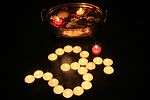
.jpg)
